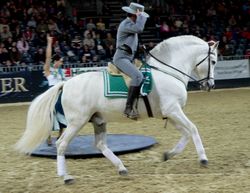Andalusian (horse)
| Andalusian (horse) | |
|---|---|

Demonstration of Spanish thoroughbred horses at the Equitana 2005 |
|
| Important data | |
| Origin: | Spain |
| Main breeding area: | Spain, especially in the southeast |
| Distribution: | worldwide |
| Stick measure : | 150-169 cm |
| Colors : | Very often gray , rarely dun , brown , black horse , occasionally foxes |
| Main application area: | Riding horse up to high school |
Andalusians are a breed of horses bred in Spain . In studbook registered horses belong to the Pura Raza Española , the "Pure Spanish race", shortly PRE.
Background information on horse evaluation and breeding can be found under: Exterior , interior and horse breeding .
To the subject
Historically, the name Andalusian comes from the fact that in the Middle Ages the entire Muslim part of the Pyrenees Peninsula , where horse breeding flourished, was called Al-Andalus . The designation of origin is basically not limited to today's region of Andalusia . However, the fact that important centers of Spanish horse breeding are actually in the southern Spanish region of Andalusia adds to the confusion.
Exterior
With a medium-sized, compact and muscular torso with a harmonious topline, the movements of the Andalusian horse are characterized by elegance and great jumping power. The noble, dry head has a straight or subconvex profile, the neck is strong and set high, the back is rather short, the shoulder sloping. The foundation is dry, sometimes easy for a well muscled hindquarters.
interior
The Andalusian is a noble Iberian horse and shows a special aptitude for the " high school ". Andalusians are very docile and sensitive animals. They are often so-called one-man horses, as they are very personal and can react cautiously towards strangers. They are considered courageous, loyal and clear-headed, as serious breeding places great emphasis on the character of a horse.
Breeding history
Until a few years ago it was believed that Andalusians and Arab horses were related to each other. However, genetic tests have now shown that the Iberian horse is descended from the original Sorraia horse. However, attempts are still being made to improve the horse breed with Arabian thoroughbreds and Berbers.
In Jerez de la Frontera in Andalusia, the Carthusian monks started their own horse breeding, supported by the royal family and influential nobles . This is considered to be the beginning of the breeding history of the famous Spanish Carthusian horses ( Cartujanos ), which belong to the PRE horses and are considered to be a particularly noble sub-breed of the Andalusian.
Horse breeding in Spain is highly fragmented and is practically exclusively operated by small private breeders, each using their own branding . There are around 3500 such brands. In Spain, besides the mostly white Andalusian, the (always black) pure-bred Menorquina ( Pura Raza Menorquina , PRM for short), for which there have been separate stud books since 1989, is bred in Iberian breeds . These horses were previously considered a sub-breed of the PRE. The horses called Tres Sangres (“three-blooded”) by Spanish breeders do not represent their own (sub) breed, but this information only expresses that three different breeds have been crossed here (mostly Andalusians, thoroughbred Arabs and English thoroughbred). Spanish horses with thoroughbred Arabian influence are referred to as "Hispano-Arabs".
From 1912 the breeding of the PRE and the Lusitano was recorded in a joint stud book under the name "Andalusian". In 1967 the breeders separated in the two directions Puro Sangue Lusitano and Pura Raza Española . The relationship between the two races can still be seen today.
See also
Literature and other media
- Katharina von der Leyen, Thomas Kilper: The Spanish Horse / Pura Raza Española , BLV Buchverlag, ISBN 3-405-16398-6
- Nicole Krier-Badila: Spain's horse of kings - origin, history and breeding of the oldest European noble horse, stud farms and breeding horses of the Pura Raza Espanola in Germany , Verlag Sandra Asmussen, Gelting, ISBN 3-935985-09-6
- Bennett, Deb: Conquerors: The Roots of New World Horsemanship , 1st. Edition, Amigo Publications Inc, Solvang, CA 1998, ISBN 0-9658533-0-6 .
- Bongianni, Maurizio (editor): Simon & Schuster's Guide to Horses and Ponies . Simon & Schuster, Inc., New York, NY 1988, ISBN 0-671-66068-3 .
- Hendricks, Bonnie: International Encyclopedia of Horse Breeds . University of Oklahoma Press, Norman, OK 2007, ISBN 978-0-8061-3884-8 .
- Jankovich, Miklos, translated by Anthony Dent: They Rode Into Europe: The Fruitful Exchange in the Arts of Horsemanship between East and West . George G. Harrap & Co, Ltd., London 1971, ISBN 0-684-13304-0 .
- Llamas, Juan, translated by Jane Rabagliati: This is the Spanish Horse . JA Allen, London 1997, ISBN 0-85131-668-9 .
- Loch, Sylvia: The Royal Horse of Europe: The Story of the Andalusian and Lusitano . JA Allen, London 1986, ISBN 0-85131-422-8 .
- Raber, Karen: A Horse of a Different Color: Nation and Race in Early Modern Horsemanship Treatises . In: Raber, Karen and Treva J. Tucker (Eds.): The Culture of the Horse: Status, Discipline, and Identity in the Early Modern World . Palgrave MacMillan, New York, NY 2005, ISBN 1-4039-6621-4 .
- Walker, Stella A Summerhays, RS: Summerhays' Encyclopaedia for Horsemen . F. Warne, London 1975, ISBN 978-0-7232-1763-3 .
Web links
Individual evidence
- ↑ PRE Standard ( Memento from October 19, 2016 in the Internet Archive )
